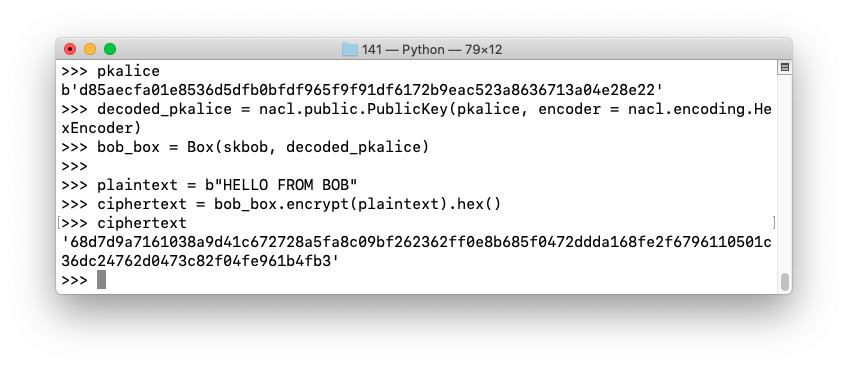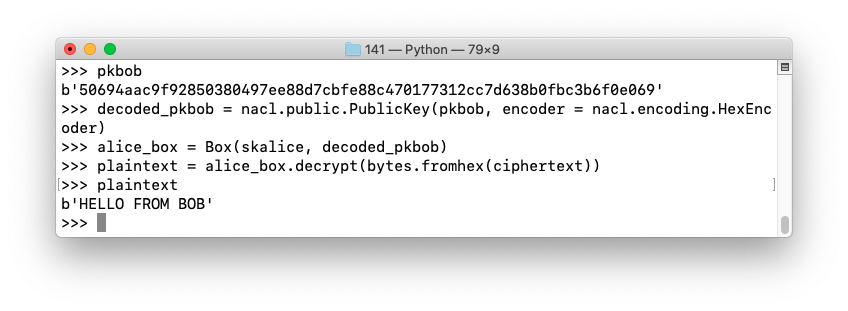
This is the modern way to manage Python, and it's required by most modern operating systems.
In a Terminal window, execute these commands:
sudo apt update
sudo apt install python3-pip python3-full -y
mkdir sodium
python3 -m venv sodium
./sodium/bin/pip install pynacl
./sodium/bin/python3
import nacl.utils
from nacl.public import PrivateKey, Box
Execute these commands:
skbob = PrivateKey.generate()
skbob.encode(encoder = nacl.encoding.HexEncoder)
pkbob = skbob.public_key.encode(encoder = nacl.encoding.HexEncoder)
pkbob
Bob will publish his public key somewhere everyone can find it, such as a Web page, and keep his private key secret.

skalice = PrivateKey.generate()
pkalice = skalice.public_key.encode(encoder = nacl.encoding.HexEncoder)
pkalice
Alice publishes her public key, just as Bob did.

Bob wants to send a message "HELLO FROM BOB" to Alice. He needs to encode Alice's public key from hexadecimal into a nacl PublicKey structure.
To do that, execute these commands:
pkalice
decoded_pkalice = nacl.public.PublicKey(pkalice, encoder = nacl.encoding.HexEncoder)
bob_box = Box(skbob, decoded_pkalice)
plaintext = b"HELLO FROM BOB"
ciphertext = bob_box.encrypt(plaintext).hex()
ciphertext
That object, together with Bob's private key, formed the shared secret key needed to create the Box object so we could encrypt the message.
The ciphertext is random-looking bytes, as shown below.

Execute these commands:
pkbob
decoded_pkbob = nacl.public.PublicKey(pkbob, encoder = nacl.encoding.HexEncoder)
alice_box = Box(skalice, decoded_pkbob)
plaintext = alice_box.decrypt(bytes.fromhex(ciphertext))
plaintext

C 431.1: Public Key (5 pts)
Larry's private key is:ec6a35628ce2a22a5580ecf5f0a26c1b9be7fb472ef1ea76fafba8b5fc280d21
Find Larry's Public Key. That's the flag.
Hint:
To use a hexadecimal value for a private key, replace these two lines:with this line:
C 431.2: Decryption with the Key (20 pts)
Felix has sent you the flag. Find the flag from the information below.
- Felix's Public Key:
c211cf597e41c250f895b52cbf56e0c01f843d23cb2aeac14abcf1ed11b9b502
- Your Public Key:
97ff076381c5d86915b6780ea3cf299b1de6ca9a52f9445e5f60899fd1f4420f
- Your Private Key:
f9a99f5cb3174818e3a46587c8979e737ad823d9d80441881cb8676ae67adbd1
- Encrypted Message:
bc24b2be13174ca12f76f4570c1b68334c5e39e32692fdb49f7bf4ddda801c66
4eec59405f7340de1351188a0ebfe1a62fb737c849ee00d94129858863